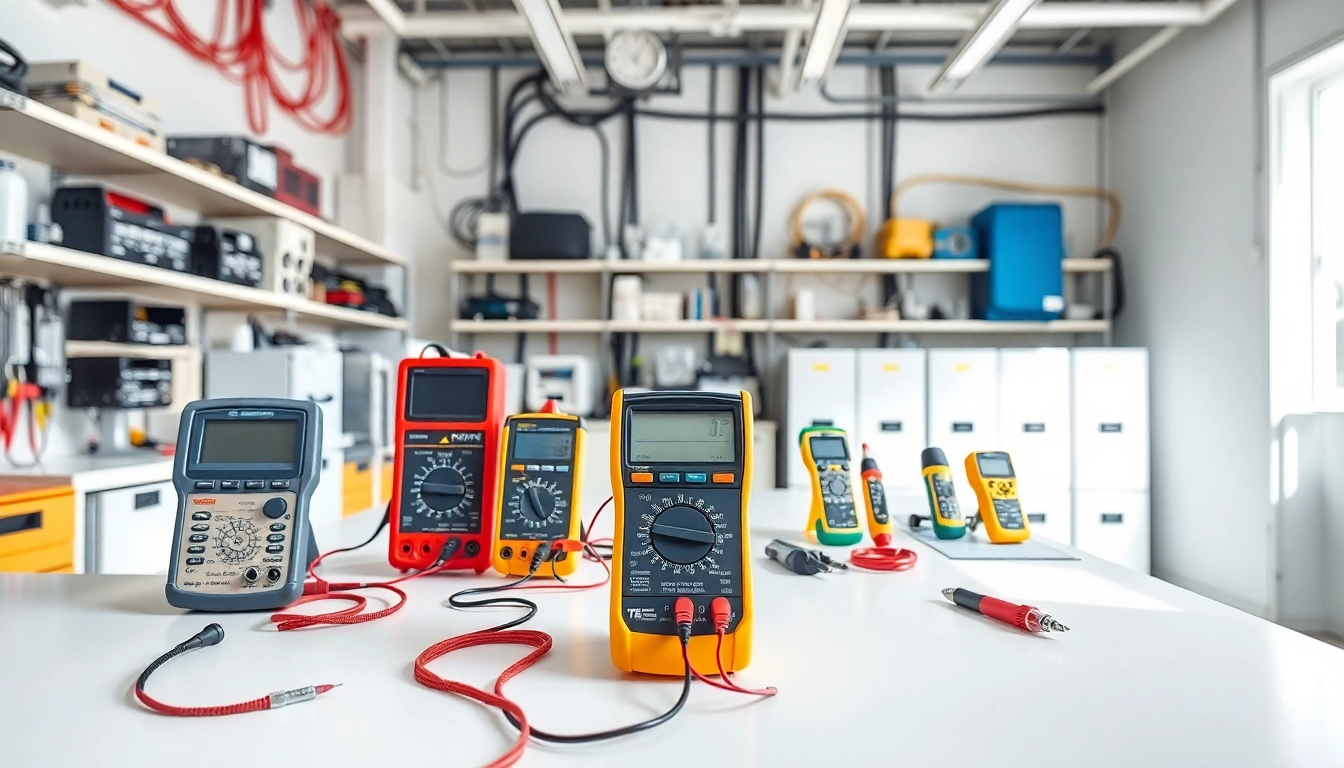Understanding Electrical Equipment Testing
Electrical equipment testing is an essential practice in ensuring safety, reliability, and compliance with regulatory standards in any setting where electrical systems and devices are used. The goal of Electrical Equipment Testing is to validate the integrity and functionality of electrical components to prevent potential hazards and minimize downtime. This comprehensive guide delves into the nuances of electrical equipment testing, exploring its importance in safety, examining testing methods used across industries, and discussing best practices for effective implementation.
What is Electrical Equipment Testing?
Electrical equipment testing encompasses a series of procedures designed to evaluate the performance and safety of electrical devices and systems. This can involve anything from simple visual inspections to complex electrical testing using specialized instruments. The process typically involves the following stages:
- Inspection of physical condition and integrity
- Verification of operational functionality
- Testing for compliance with safety standards
- Documentation of findings and recommendations
Testing plays a pivotal role not just in maintaining equipment but also in ensuring worker safety, detecting potential failures before they occur, thus preventing costly repairs or accidents.
Importance of Electrical Equipment Testing for Safety
One of the foremost reasons for conducting electrical equipment testing is safety. Electrical faults account for a significant percentage of accidents in workplaces, including electrical shocks, fires, and equipment failures. Testing helps in identifying risks associated with faulty wiring, insulation breakdowns, and equipment malfunctions. By rigorously testing electrical equipment, companies can:
- Mitigate risks and protect employee health
- Meet legal and regulatory requirements for workplace safety
- Enhance equipment reliability and prolong lifespan
- Avoid costly downtime and repair expenses
Ensuring thorough electrical testing is not merely a best practice but a moral obligation for businesses that prioritize the well-being of their employees and clients.
Common Testing Methods Used in the Industry
Electrical testing methodologies can vary widely depending on the type of equipment, the industry standards, and the applications involved. However, some of the most common testing methods include:
- Visual Inspection: A preliminary assessment aimed at identifying obvious signs of wear and tear, damage, or unsafe conditions.
- Insulation Resistance Testing: Measures the resistance of electrical insulation to ensure it is functioning correctly, protecting against leakage currents.
- Functional Testing: Verifies that the equipment operates as intended in simulated environments, ensuring it meets specifications.
- Ground Bond Testing: Checks the integrity and effectiveness of the device grounding to ensure safety is maintained.
Employing a combination of these methods can enhance the comprehensive evaluation of electrical systems and aid in compliance with prevailing standards.
Types of Electrical Equipment Tests
Visual Inspection and Its Significance
Visual inspection serves as the first line of defense in electrical equipment testing. Trained personnel look for visible signs of damage, wear, or potential safety hazards, which may include:
- Cracks in insulation
- Loose connections and corrosion
- Overheating evidence, such as discoloration or burning smells
By identifying such issues early on, organizations can address them proactively, minimizing risk and ensuring safety in their operations.
Insulation Resistance Testing Explained
Insulation resistance testing is a critical procedure that assesses the insulation’s integrity surrounding electrical components. It ensures that electrical currents do not escape to unintended paths, which may pose safety risks. During this test, a high voltage is applied to the insulation, measuring the resistance in megohms. High resistance values indicate good insulation, while low resistance can signify deterioration, requiring immediate remediation.
In many industries, a minimum insulation resistance value is specified by safety standards, and regular tests can help ensure compliance with these regulations and maintain safe operational conditions.
Functional Testing of Electrical Equipment
Functional testing involves operating the electrical equipment under predetermined conditions to assess its performance against operational standards. This testing assesses:
- Operational capabilities of the equipment
- System responses to realistic loads and conditions
- Correct responses to control signaling and failure modes
Functional testing plays a crucial role in quality assurance, ensuring equipment fulfills intended purposes and confirming equipment is safe and ready for deployment.
Key Tools for Electrical Equipment Testing
Essential Equipment Overview
Having the right tools is paramount to conducting effective electrical testing. Some essential equipment includes:
- Multimeters: Used for measuring voltage, current, and resistance.
- Insulation Resistance Testers: Specifically designed to measure insulation resistance.
- Clamp Meters: For measuring current without physical contact with circuits.
- Earth Testers: To ensure grounding integrity.
Investing in high-quality tools not only improves testing accuracy but also enhances the safety of those performing the tests.
Choosing the Right Test Instruments
Choosing the appropriate testing instruments is crucial to effective electrical equipment testing. Factors to consider include:
- Specifications: Ensure instruments can handle the necessary voltage and current ratings.
- Manufacturers’ Standards: Select instruments that comply with international testing standards.
- Ease of Use: Opt for instruments that come with user-friendly interfaces and comprehensive manuals.
- Calibration and Maintenance: Instruments should be easy to calibrate and maintain to ensure ongoing accuracy.
Investing time in research and understanding the tools available can drastically improve the reliability of the electrical testing process.
Latest Innovations in Testing Technology
The electrical testing industry is continuously evolving, with technological advancements bringing forth sophisticated testing solutions. Some of the latest innovations include:
- Smart Testing Equipment: Devices that can integrate with cloud technology, enabling remote monitoring and data analytics.
- Automated Testing Systems: Reduction in human error with automated test equipment capable of running complex testing sequences.
- IoT Devices for Monitoring: Devices that communicate in real-time about equipment conditions, extending beyond periodic testing to continuous monitoring.
Keeping up with innovation not only enhances the precision of testing but also increases efficiency and safety standards within the workplace.
Compliance and Standards in Electrical Equipment Testing
Regulatory Bodies and Their Guidelines
In the realm of electrical equipment testing, various regulatory bodies create and enforce standards that organizations must follow. Key players include:
- Occupational Safety and Health Administration (OSHA): Oversees workplace safety and sets regulations to protect workers.
- National Fire Protection Association (NFPA): Establishes guidelines for fire risk assessments related to electrical equipment.
- International Electrotechnical Commission (IEC): Develops international standards for electrical apparatus and safety regulations.
- Institute of Electrical and Electronics Engineers (IEEE): Provides valuable research and standards for electrical testing methods.
These institutions set industry benchmarks and ensure that equipment operates safely, reducing risks associated with electrical hazards.
Understanding Electrical Safety Standards
Various safety standards frame the compliance landscape in electrical testing, crucial for ensuring all aspects of projects meet national and international safety norms. Familiarizing oneself with standards such as:
- IEC 61010: Safety requirements for electrical equipment for measurement, control, and laboratory use.
- NFPA 70E: Standards addressing electrical safety in the workplace.
- ANSI/ISA 12.12.01: Standards for testing electrical equipment utilized in hazardous locations.
Understanding and implementing these standards is essential for maintaining compliance and ensuring the safety of personnel and equipment.
Documentation and Reporting Compliance
Documentation is a vital aspect of electrical equipment testing, encompassing all test results, procedures, and certifications. Proper documentation aids in demonstrating compliance to regulatory bodies and maintaining an audit trail. It should include:
- Test reports detailing procedures, results, and equipment used
- Certificates of compliance with applicable standards
- Records of maintenance, calibration, and training provided to personnel
Moreover, consistent documentation enhances future testing procedures, facilitating continuous improvement in operational protocols and safety measures.
Best Practices for Effective Electrical Equipment Testing
Creating a Testing Schedule
Establishing a testing schedule helps in structuring maintenance and testing activities appropriately. The schedule should be built considering:
- Type of equipment and its usage intensity
- Manufacturer recommendations for testing frequencies
- Applicable legal and regulatory mandates
Creating and following a structured schedule not only aids in preemptive testing but also aligns with compliance requirements, helping organizations avoid penalties and enhance safety standards.
Training Personnel in Safety Protocols
The effectiveness of electrical equipment testing heavily relies on the competence of the personnel conducting it. Implementing training programs with these aspects in mind is vital:
- Understanding various testing methods and their significance
- Hands-on experience with testing instruments
- Knowledge of local and international safety regulations
- Emergency procedures and first aid
By investing in training, organizations enhance both safety and efficiency, as knowledgeable personnel are less likely to make errors that could lead to accidents or equipment failures.
Maintaining and Calibrating Testing Equipment
Continuous maintenance and calibration of testing equipment are crucial to ensuring accuracy and reliability. Key practices include:
- Regular check-up schedules for all testing devices
- Calibrating instruments according to manufacturer specifications
- Storing equipment in appropriate environments to prevent damage
- Documenting maintenance and calibration checks for audit trails
Adhering to these practices not only enhances the credibility of testing results but also ensures compliance with regulatory standards, fostering a safe operational environment.



